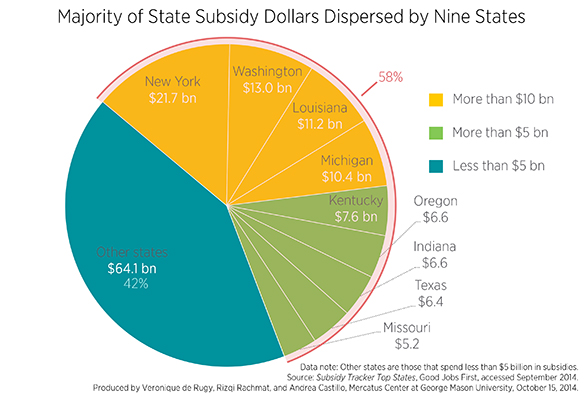- | Government Spending Government Spending
- | Data Visualizations Data Visualizations
- |
Ranking Known State Subsidies to Private Businesses
This week’s charts use data from the Subsidy Tracker 2.0 dataset compiled by Good Jobs First, a government accountability and smart-growth advocacy group, to display the states (plus the District of Columbia) that disperse the highest amounts and numbers of subsidies, along with the top parent corporations that cumulatively benefit from these subsidies.

While corporate welfare, whether in the form of subsidies or bailouts, is more often associated with the federal government, state governments also regularly use generous, targeted subsidy packages to entice corporations to locate within their borders. As these charts show, corporate welfare is a significant problem at the state level, with New York State leading the rest.

This week’s charts use data from the Subsidy Tracker 2.0 dataset compiled by Good Jobs First, a government accountability and smart-growth advocacy group, to display the states (plus the District of Columbia) that disperse the highest amounts and numbers of subsidies, along with the top parent corporations that cumulatively benefit from these subsidies.
Comprehensive data on total state assistance to private businesses have long been hard to access, since the relevant information has been inconsistently scattered among various government reports and websites. The Subsidy Tracker project is an ambitious effort to compile state data on subsidized projects, amounts, beneficiaries, and outcomes in one location. The dataset distinguishes between 11 types of subsidies, including tax credits and rebates, property tax abatements, low-cost loans, infrastructure assistance, and enterprise zones.
The dataset is a constantly updated work-in-progress. It contains only data for projects that researchers were able to procure from state governments. For some states, the data includes known projects going back to the 1970's and 1980's. States for which researchers were able to compile data from more years will likely have higher subsidy amounts reported than those for which researchers only have recent data. For example, most of the data for California consistutes projects undertaken in 2012 and after. A smaller state like Missouri, for which most of the data comes from 2005 and on, is ranked higher than California partly because of the discrepancy between the years covered. But while the dataset does not yet contain every single state subsidy, it is one of the most comprehensive sources of state subsidies assembled so far.
Additionally, the database compilers decided to count sales tax exemptions on business purchases of inputs as a “subsidy.” However, some economists argue that applying sales taxes to input purchases would inefficiently favor vertically integrated firms over firms that purchase inputs from other businesses. Therefore, this kind of sales tax exemption is not a “subsidy,” but an efficient tax policy. Despite these important limitations, the dataset can give us an early glimpse of the rough value of the subsidies that each state issues. The User Guide provides further details on the methodology.
The first chart displays the states known to have extended cumulative subsidies exceeding $1 billion, according to the dataset. In the top portion, the states are ranked, left to right, from the highest amount of subsidies to the lowest amount of subsidies. In the bottom portion, the equivalent number of deals are displayed for each state.
New York state clearly leads the pack, extending a known 71,759 subsidy deals worth $21.71 billion. The second highest corporate beneficiary in the dataset, Alcoa, received a plum deal from the Empire State in 2007, raking in an astounding $5.6 billion to build an aluminum plant.
Indeed, many of the states known to have extended the most subsidies to private businesses are home to well-connected manufacturers. Washington State, the second-highest offender, houses manufacturing facilities for Boeing, no stranger to government subsidies. Many of Michigan’s subsidies benefit struggling automobile manufacturers like General Motors and Ford. In Louisiana, energy companies like Sempra Energy and Cheniere Energy soak up subsidies.

The second chart highlights the dispersion of the growing problem of state subsidies. In total, states have issued over $152.9 billion in known subsidies to private businesses. All states but two dispersed at least over $5 million each; however, the top offenders are major offenders. The chart shows that the known subsidy dollars extended by the top nine states constitute 58 percent of all known subsidies.

The third chart displays the parent companies that ultimately benefit from state subsidies. The chart shows that established corporations, not small businesses or startups, are the overwhelming recipients of state benefits. Sometimes, subsidies are extended to subsidiary companies that appear small and unconnected at first glance. The Subsidy Tracker 2.0 database connected subsidiary companies to their parent companies to provide a clearer picture of the top beneficiaries. Many of these companies are habitual “double-dippers”; Boeing benefits handsomely from federal Export-Import Bank subsidies, General Motors was famously bailed out by the federal government, and Tesla Motors and Ford Motor received assistance from the Energy Department’s Advanced Technology Vehicles Manufacturing (ATVM) loan program.
Targeted state subsidies to private businesses are often promoted as a “market-friendly” means to boost growth, jobs, and development. However, the empirical studies on state subsidies find that these programs have little to no effect in producing their intended goals.
What’s more, as Christopher Coyne and Lotta Moberg write in their recent Mercatus working paper, “The Political Economy of State-Provided Targeted Benefits,” these subsidies are often ultimately damaging. Targeted state subsidies misallocate scarce public resources while encouraging rent-seeking, regulatory capture, and cronyism. To encourage sustainable state economic growth, policymakers should shift their focus away from tailoring policies to benefit specific firms toward policies that create a general environment in which all can flourish. The first step is to end the practice of targeted state subsidies.